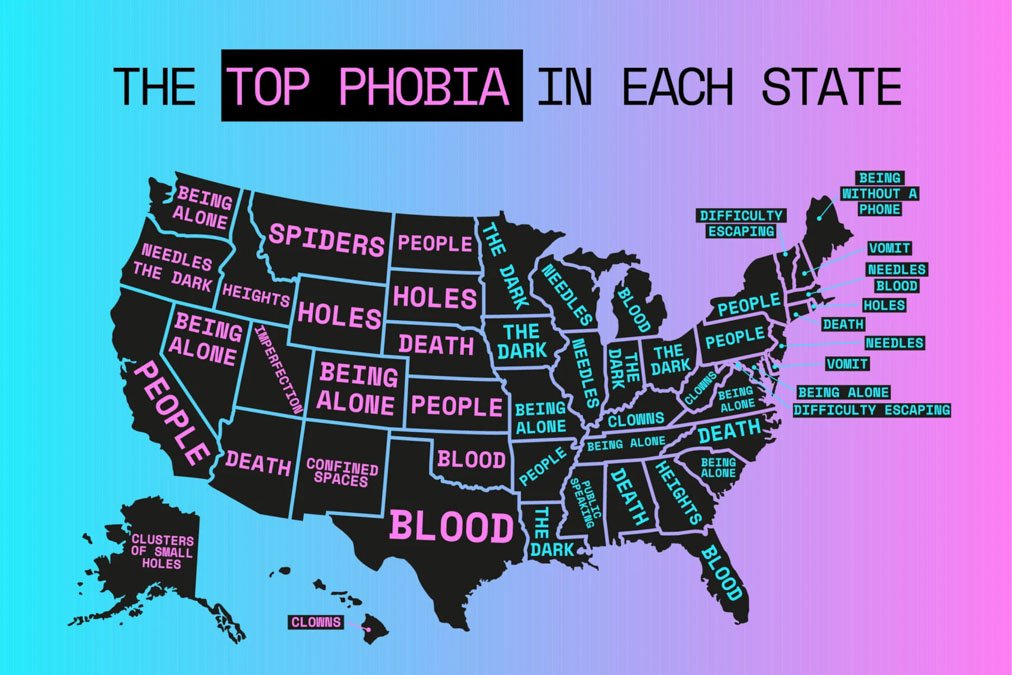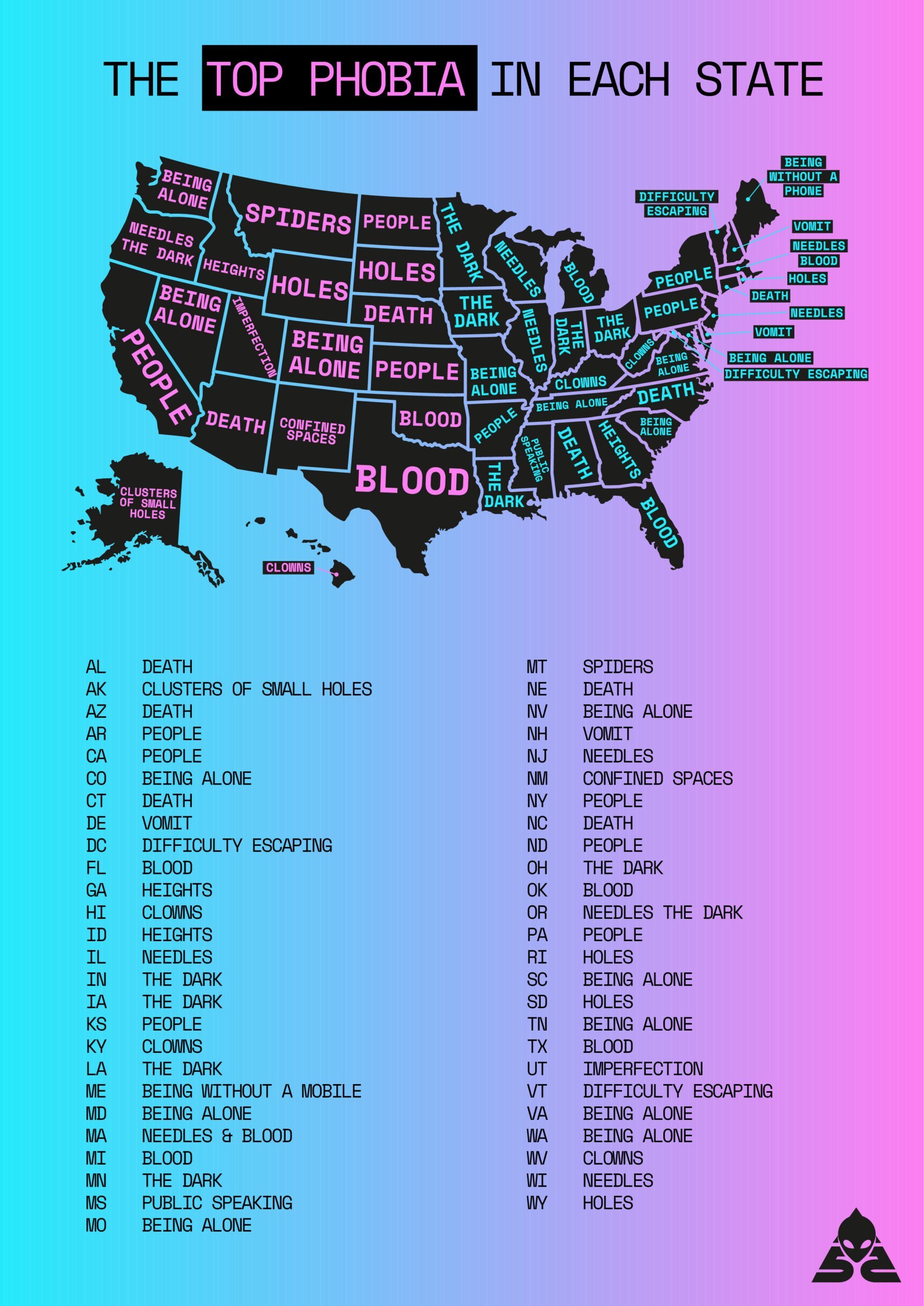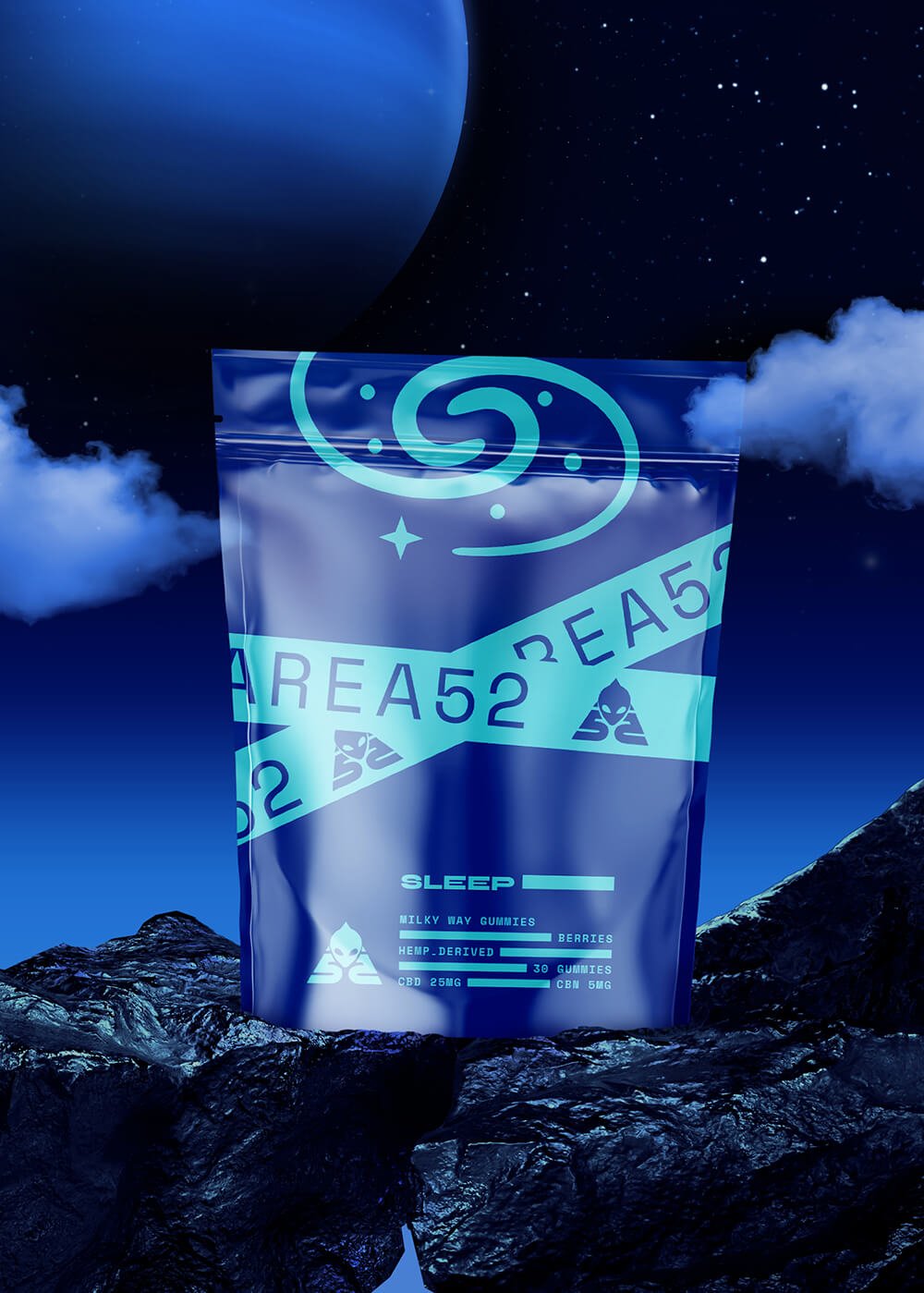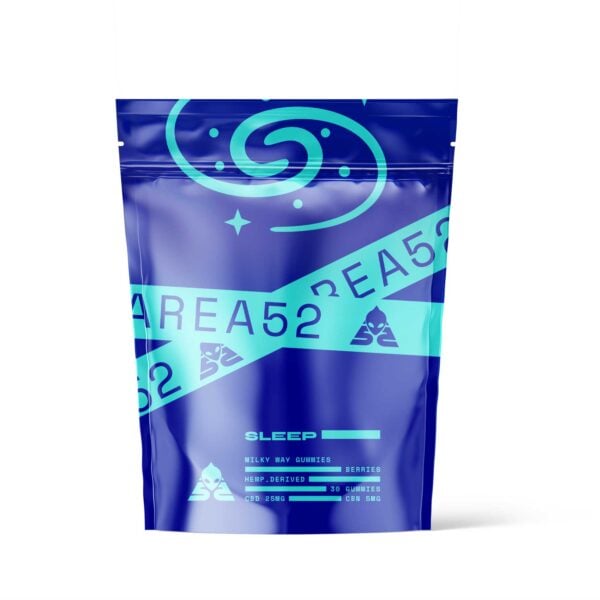Phobia Statistics in the US – Which fears are most common in your state?

Halloween is approaching and a lot of scary things have happened this year but have you ever wondered what really scares US citizens?
Our new research on phobia & fear statistics reveals the top fears in each US state and which fears are overall the most common across the country… it may surprise you.
Which Phobia is Most Popular in the biggest States?

Three out of five most populated states are scared of people 😳
California– Interestingly, with a large population of 39,613,493, California is the most Anthropophobic state, with a fear of people! With California being the third-largest state by area and the largest in population – the likelihood of having to see another person is pretty high with 1 in 8 US residents living there!
Texas – The state of the brave, and both the second-largest state by population and size, was revealed as being the most Hemophobic, (scared of blood). We recommend avoiding any old westerns over the holidays!
Florida – The sunshine state was revealed as being afraid of blood, no surprise blood is linked to doom and gloom and quite possibly the most common theme in Halloween! Thankfully if you just avoid horror films this season you should get away with not having to see any blood.
New York – The city that never sleeps. It is surprising that New Yorkers are most scared of people! Being in a city where one report found you have a 15% chance of bumping into someone you know, let alone someone you don’t! Maybe it’s time to take a trip to the Hampdens this season?
Pennsylvania – In the 2020 U.S. Census it was revealed that Pennsylvania is the 9th most densely populated state in the U.S. It is also the most scared of people! I doubt you’ll see many people out trick or treating this halloween!
It is interesting that the largest states are most affected by Anthropophobia. Although, this could be linked to the idea of not having any personal space or having to avoid those around them for the last year…
Top searched fears in the US

The top three most feared common phobias in the US are…
Nyctophobia – fear of the dark
Does the idea of all the lights being turned off cause you panic and anxiety? Nyctophobia is extremely common in both young children and adults and it is no surprise it is one of the top searched for fears across the US – we are used to having access to light and especially this spooky season no one wants to be walking along a dark road by themselves.
Anthropophobia – Fear of People
Although this term isn’t officially used within the medical society, the fear of people is real! Anthropophobia causes people to experience extreme feelings of social anxiety. In a country nearly as large as most continents it is no surprise that citizens are feeling overwhelmed by other people, especially after a year of being told to avoid others and keep your distance.
Monophobia – Fear of Being Alone or Isolated
Most people have a deep-rooted fear of being alone, but for some people, it is much more than that! As humans, we naturally gravitate to other humans, and similarly to Anthropophobia, Monophobia is a form of social anxiety but on the opposite spectrum. If you’re feeling like this, it is most likely others around you are too!
Table of US states and their top searched for fears
| Abbreviation | State | Top searched for fears |
| CA | California | Anthropophobia |
| TX | Texas | Hemophobia |
| FL | Florida | Hemophobia |
| NY | New York | Anthropophobia |
| PA | Pennsylvania | Anthropophobia |
| IL | Illinois | Trypanophobia |
| OH | Ohio | Nyctophobia |
| GA | Georgia | Acrophobia |
| NC | North Carolina | Thanatophobia |
| MI | Michigan | Hemophobia |
| NJ | New Jersey | Trypanophobia |
| VA | Virginia | Monophobia |
| WA | Washington | Monophobia |
| AZ | Arizona | Thanatophobia |
| TN | Tennessee | Monophobia |
| MA | Massachusetts | Trypanophobia & Hemophobia |
| IN | Indiana | Nyctophobia |
| MO | Missouri | Monophobia |
| MD | Maryland | Monophobia |
| CO | Colorado | Monophobia |
| WI | Wisconsin | Trypanophobia |
| MN | Minnesota | Nyctophobia |
| SC | South Carolina | Monophobia |
| AL | Alabama | Thanatophobia |
| LA | Louisiana | Nyctophobia |
| KY | Kentucky | Coulrophobia |
| OR | Oregon | Trypanophobia& Nyctophobia |
| OK | Oklahoma | Hemophobia |
| CT | Connecticut | Thanatophobia |
| UT | Utah | Atelophobia |
| NV | Nevada | Monophobia |
| IA | Iowa | Nyctophobia |
| AR | Arkansas | Anthropophobia |
| MS | Mississippi | Glossophobia |
| KS | Kansas | Anthropophobia |
| NM | New Mexico | Claustrophobia |
| NE | Nebraska | Thanatophobia |
| ID | Idaho | Acrophobia |
| WV | West Virginia | Coulrophobia |
| HI | Hawaii | Coulrophobia |
| NH | New Hampshire | Emetophobia |
| ME | Maine | Nomophobia |
| MT | Montana | Arachnophobia |
| RI | Rhode Island | Trypophobia |
| DE | Delaware | Emetophobia |
| SD | South Dakota | Trypophobia |
| ND | North Dakota | Anthropophobia |
| AK | Alaska | Trypophobia |
| DC | District of Columbia | Agoraphobia |
| VT | Vermont | Agoraphobia |
| WY | Wyoming | Trypophobia |
Methodology
The data is based on 51 states, including the District of Columbia.
Using Google Keyword Tool Area52 analyzed 49 fears, chosen from The Chapman University Survey of American Fears Wave 7 (2020/2021) study. Those were then analyzed against Google Trends data to see which fear US states were most affected by.
Phobias vs Fears: Are They the Same?
Phobias and fears are similar in that they can both trigger the fight-or-flight response in people. However, fear is a normal response to perceived danger or threat and typically goes away once the stressor is removed.
On the other hand, phobia is a type of anxiety disorder characterized by an irrational, persistent, and intense fear response to something. The reaction to the stressor is, more often than not, disproportionate to the actual threat or danger, and the extreme fear also sometimes triggers panic attacks, resulting in severe impairment in daily functioning.
The Diagnostic and Statistical Manual of Mental Disorders (DSM) classifies this mental illness into five general types, under which are the specific phobias [1]:
- Animal phobias, which also include insects, reptiles, and birds
- Natural environment phobias, which include water (lakes, rivers, oceans, etc.) heights, or lightning
- Blood-injection injury phobias, which include surgeries, seeing blood, needles, or injections
- Situational phobias, which include elevators, flying, driving, going out of the house, or enclosed spaces
- Other phobias, which include costumed characters like clowns, loud noises, or situations that may cause vomiting or choking
FAQs on Common Phobia & Fears Statistics
Want to learn more about common fears and phobias? Then check out our FAQ below.
1. What Triggers Fear?
Fear is a normal reaction triggered by anything a person perceives as a threat or a danger to their mental and physical well-being. This activates the body’s fight-or-flight response, resulting in increased heartbeat, rapid breathing, cold sweats, trembling, muscle tension, and anxiety.
2. What is the #1 Most Feared Thing?
According to the Chapman Survey of American Fears (2024), the #1 most feared thing in America is corrupt government officials, with 65.2% of respondents saying they’re either afraid or very afraid of this specific fear. A loved one falling seriously ill ranked second, with 58.4%, up from fifth place in 2023. Cyberterrorism ranked third at 58.3%, up from ninth place last year [2].
Rounding off the top 10, the other fears include:
- Death of a Loved One: 57.8%, up from sixth place
- Russia Launching a Nuclear Attack: 55.8%, down from 3rd place
- Lack of Financial Security for the Future: 55.7%, up from 10th place
- The US Getting Involved in a New World War: 55%, down from 4th place
- North Korea Launching a Nuclear Attack: 55%, up from 12th place
- Terrorist Attack: 52.7%, up from 16th place
- Biologic Warfare: 52.5%, down from 8th place
3. What Percent of the Population Fears Death?
Ranked 51st in the Chapman Survey of American Fears (2024), around 31.6% of Americans fear dying. This is up from 66th place in 2023 [2,3].
4. What Percentage of the Population Has a Phobia?
According to the National Comorbidity Survey Replication, nearly 1 in 10 (9.1%) American adults dealt with a specific phobia over the past year. It has a lifetime prevalence of around 12.5%, which means that around 1 in 8 American adults will deal with some type of specific phobia at some point in their lifetimes. This common anxiety disorder affects females (12.2%) more than males (5.8%) [4].
5. What are 5 Facts About Phobias?
Below are five facts about phobias:
- Phobias often occur with other mental disorders, and about 25% to 72% of patients with specific phobias are also diagnosed with at least one psychiatric condition such as major depressive disorder, other anxiety disorders, personality disorders, and substance use disorder, among others [5].
- Around 3% to 15% of people worldwide will suffer from specific phobias at some point in their lifetimes, the most common of which are animal and situational phobias [6]. People with phobias also have a higher risk of developing chronic health issues such as heart and lung problems.
- Environmental risk factors such as traumatic events and childhood experiences contribute to the development of phobias. Notable risk factors also include genes, parental and social influences, and substance abuse.
- Phobias affect a person’s day-to-day life, with 21.9% of those with specific phobias dealing with serious impairment. Around 30% experience moderate impairment, while 48.1% deal with mild impairment.
- Specific phobias are highly treatable.
6. What is the #1 Phobia in the World?
According to the Netherlands Mental Health Survey and Incidence Study results, the most common type of specific phobia was fear of heights, affecting 4.9% of the general population [7].
7. What is the Rarest Phobia?
Below are some of the rarest phobias mentioned in studies (8,9,10]:
- Alektorophobia: Fear of chickens
- Turophobia: Fear of cheese
- Thermophobia: Fear of heat
- Ligyrophobia: Fear of loud noises
8. What is the Weirdest Phobia?
Some of the weirdest phobias include [11]:
- Omphalophobia: Fear of navels
- Nomophobia: Fear of not having your mobile phone and cell service
- Arachibutyrophobia: Fear of having peanut butter stuck to the roof of the mouth
- Lachanophobia: Fear of veggies
- Geniophobia: Fear of chins
9. What is the Longest Phobia?
The longest phobia is aptly called hippopotomonstrosesquippedaliophobia. It literally means fear of long words.
10. Can Phobias Be Cured?
Yes, phobias can be cured with cognitive behavioral therapy as well as desensitization or exposure therapy. Medicines may also be given to control the physical symptoms of phobia, such as higher-than-normal blood pressure, rapid heartbeat, trembling, and increased anxiety. However, only 10% to 25% of people with specific phobias receive treatment for the disorder [12].
About Area 52
Area 52 is a CBD company that specializes in delta 8. It believes in the medicinal aspects of CBD oil, which can play an integral role in the process of self-growth and development.
References:
- Samra CK, Torrico TJ, Abdijadid S. Specific Phobia. [Updated 2024 Aug 12]. In: StatPearls [Internet]. Treasure Island (FL): StatPearls Publishing; 2025 Jan-. Available from: https://www.ncbi.nlm.nih.gov/books/NBK499923/
- Chapman University. (2024). Chapman Survey of American Fears: High to low rankings. Wilkinson College of Arts, Humanities, and Social Sciences, Earl Babbie Research Center. Retrieved from https://www.chapman.edu/wilkinson/research-centers/babbie-center/_files/2024-csaf-fears-high-to-low.pdf
- Chapman University. (2023). Chapman Survey of American Fears: High to low rankings. Wilkinson College of Arts, Humanities, and Social Sciences, Earl Babbie Research Center. Retrieved from https://www.chapman.edu/wilkinson/research-centers/babbie-center/_files/2023%20Fear/23csaf-9_high-to-low.pdf
- Specific phobia. (n.d.). National Institute of Mental Health (NIMH). https://www.nimh.nih.gov/health/statistics/specific-phobia
- Örengül, A. C., Meral, Y., & Görmez, V. (2019). Risk factors and comorbidity in childhood specific phobias. Journal of Cognitive Behavioral Psychotherapy and Research, 8(2), 81–86. Retrieved from https://jcbpr.org/storage/upload/pdfs/1708009956-en.pdf
- Eaton WW, Bienvenu OJ, Miloyan B. Specific phobias. Lancet Psychiatry. 2018;5(8):678-686. doi:10.1016/S2215-0366(18)30169-X
- Depla, M. F., ten Have, M. L., van Balkom, A. J., & de Graaf, R. (2008). Specific fears and phobias in the general population: results from the Netherlands Mental Health Survey and Incidence Study (NEMESIS). Social psychiatry and psychiatric epidemiology, 43(3), 200–208. https://doi.org/10.1007/s00127-007-0291-z
- Trivedi SK, Mangot AG, Munoli RN. A rare case of alektorophobia treated successfully with graded exposure therapy. Ind Psychiatry J. 2016;25(1):116-118. doi:10.4103/0972-6748.196039
- Sönmez, D., Avcı, İ. K., & Hocaoglu, Ç. (2022). A Rare Known Specific Phobia “Turophobia”: A Case Report. Eastern Journal of Medicine, 27(4), 668-671. Retrieved from https://www.researchgate.net/publication/344457191_A_Little_-known_Specific_Phobia_’Turophobia’_a_case_report
- Thati A, Bhogaraju A. A rare case with different presentation of specific phobia: Case Report. Indian J Psychiatry. 2022;64(Suppl 3):S658-S659. doi:10.4103/0019-5545.341929
- Kane, S. (2016, June 1). 25 of the strangest phobias that plague our minds. Business Insider. https://www.businessinsider.com/weirdest-phobias-fears-2016-6
- Eaton, W. W., Bienvenu, O. J., & Miloyan, B. (2018). Specific phobias. The lancet. Psychiatry, 5(8), 678–686. https://doi.org/10.1016/S2215-0366(18)30169-X






